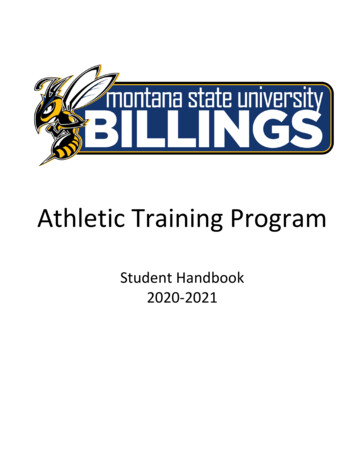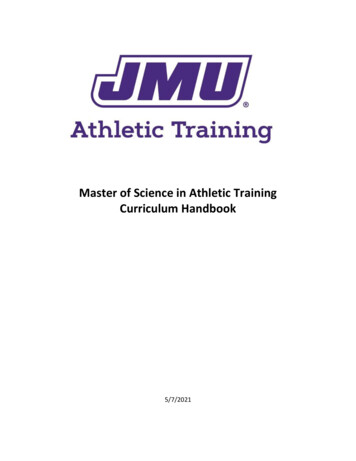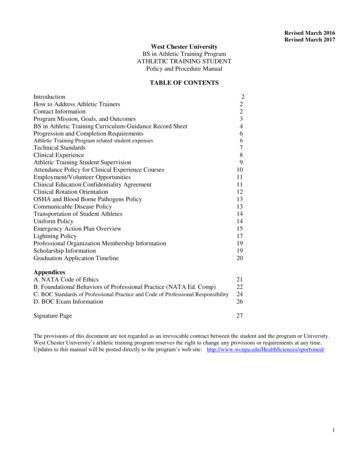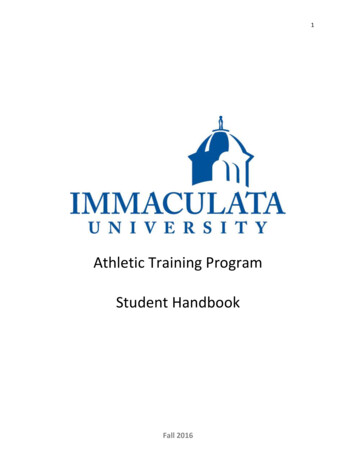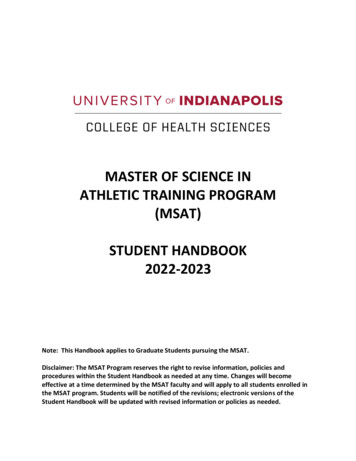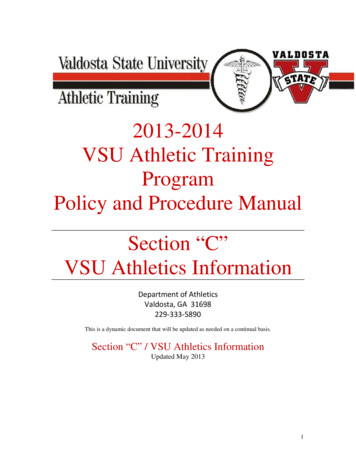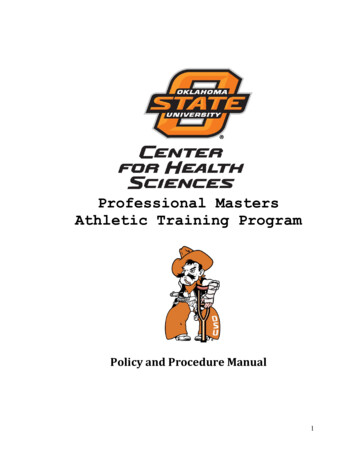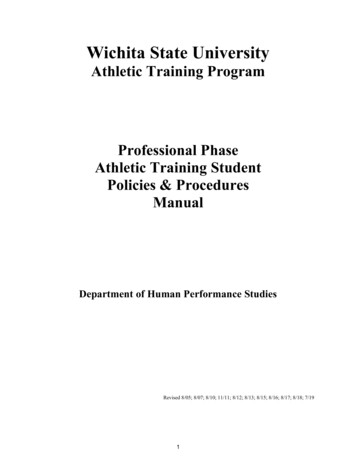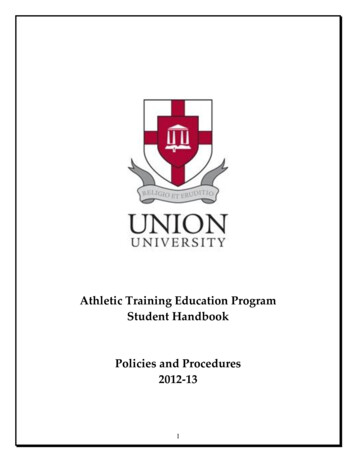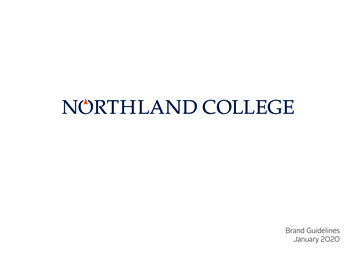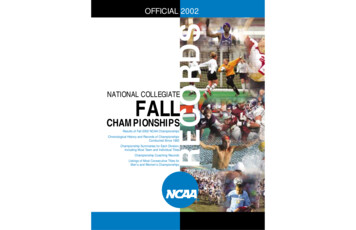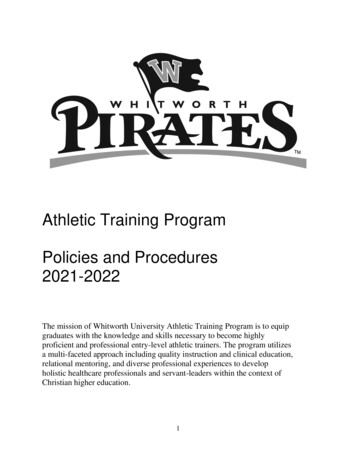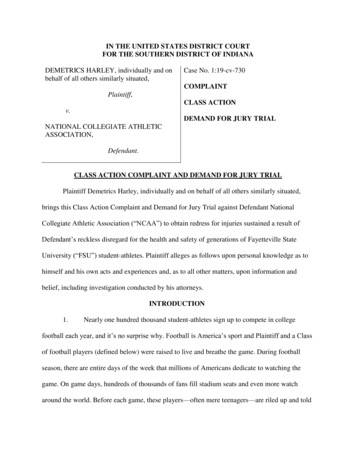
Transcription
IN THE UNITED STATES DISTRICT COURTFOR THE SOUTHERN DISTRICT OF INDIANADEMETRICS HARLEY, individually and onbehalf of all others similarly situated,Case No. 1:19-cv-730COMPLAINTPlaintiff,CLASS ACTIONv.DEMAND FOR JURY TRIALNATIONAL COLLEGIATE ATHLETICASSOCIATION,Defendant.CLASS ACTION COMPLAINT AND DEMAND FOR JURY TRIALPlaintiff Demetrics Harley, individually and on behalf of all others similarly situated,brings this Class Action Complaint and Demand for Jury Trial against Defendant NationalCollegiate Athletic Association (“NCAA”) to obtain redress for injuries sustained a result ofDefendant’s reckless disregard for the health and safety of generations of Fayetteville StateUniversity (“FSU”) student-athletes. Plaintiff alleges as follows upon personal knowledge as tohimself and his own acts and experiences and, as to all other matters, upon information andbelief, including investigation conducted by his attorneys.INTRODUCTION1.Nearly one hundred thousand student-athletes sign up to compete in collegefootball each year, and it’s no surprise why. Football is America’s sport and Plaintiff and a Classof football players (defined below) were raised to live and breathe the game. During footballseason, there are entire days of the week that millions of Americans dedicate to watching thegame. On game days, hundreds of thousands of fans fill stadium seats and even more watcharound the world. Before each game, these players—often mere teenagers—are riled up and told
to do whatever it takes to win and, when playing, are motivated to do whatever it takes to keepgoing.2.But up until 2010, Defendant NCAA kept players and the public in the dark aboutan epidemic that was slowly killing college athletes.3.During the course of a college football season, athletes absorb more than 1,000impacts greater than 10 Gs (gravitational force) and, worse yet, the majority of football-relatedhits to the head exceed 20 Gs, with some approaching 100 Gs. To put this in perspective, if youdrove your car into a wall at twenty-five miles per hour and weren’t wearing a seatbelt, the forceof you hitting the windshield would be around 100 Gs. Thus, each season these 18, 19, 20, and21-year-old student-athletes are subjected to repeated car accidents.4.Over time, the repetitive and violent impacts to players’ heads led to repeatedconcussions that severely increased their risks of long-term brain injuries, including memoryloss, dementia, depression, Chronic Traumatic Encephalopathy (“CTE”), Parkinson’s disease,and other related symptoms. Meaning, long after they played their last game, they are left with aseries of neurological events that could slowly strangle their brains.5.For decades, Defendant NCAA knew about the debilitating long-term dangers ofconcussions, concussion-related injuries, and sub-concussive injuries (referred to as “traumaticbrain injuries” or “TBIs”) that resulted from playing college football, but recklessly disregardedthis information to protect the very profitable business of “amateur” college football.6.While in school, FSU football players were under Defendant’s care.Unfortunately, Defendant did not care about the off-field consequences that would hauntstudents, like Plaintiff Harley, for the rest of their lives.2
7.Despite knowing for decades of a vast body of scientific research describing thedanger of traumatic brain injuries (“TBIs”) like those Plaintiff experienced, Defendant failed toimplement adequate procedures to protect Plaintiff and other FSU football players from the longterm dangers associated with them. They did so knowingly and for profit.8.As a direct result of Defendant’s acts and omissions, Plaintiff and countlessformer FSU football players suffered brain and other neurocognitive injuries from playingNCAA football. As such, Plaintiff brings this Class Action Complaint in order to vindicate thoseplayers’ rights and hold the NCAA accountable.PARTIES9.Plaintiff Demetrics Harley is a natural person and citizen of the State of SouthCarolina.10.Defendant NCAA is an unincorporated association with its principal place ofbusiness located at 700 West Washington Street, Indianapolis, Indiana 46206. Defendant NCAAis not organized under the laws of any State, but is registered as a tax-exempt organization withthe Internal Revenue Service. As such, Defendant NCAA is a citizen of the State of Indianapursuant to 28 U.S.C. § 1332(d)(10).JURISDICTION AND VENUE11.This Court has subject matter jurisdiction over Plaintiff’s claims under 28 U.S.C.§ 1332(d)(2) because (a) at least one member of the Class, which consists of at least 100members, is a citizen of a different state than Defendant, (b) the amount in controversy exceeds 5,000,000, exclusive of interest and costs, and (c) none of the exceptions under that subsectionapply to this action.3
12.This Court has personal jurisdiction over Defendant NCAA because it conductssignificant business in this District, including establishing consumer and business contracts here,and because it maintains its principal place of business in this District.13.Venue is proper in this District pursuant to 28 U.S.C. § 1391 because a substantialpart of the events and omissions giving rise to Plaintiff’s claims occurred in and/or emanatedfrom this District, and because Defendant NCAA resides here.FACTUAL BACKGROUNDI.Defendant Had A Duty To Protect FSU Student-Athletes, Including Plaintiff.14.The NCAA is the governing body of collegiate athletics that oversees twenty-three college sports and over 400,000 students who participate in intercollegiate athletics,including the football program at FSU. According to the NCAA, more than 1,200 schools,conferences and affiliate organizations collectively invest in improving the experiences ofathletes—on the field, in the classroom, and in life.15.The NCAA brings in more than 750 million in revenue each year and is the mostsignificant college sports-governing body in the United States.16.The NCAA plays a significant role in governing and regulating the FSU footballprogram and owes a duty to safeguard the well-being of its student-athletes.17.In fact, since its founding in 1906, the NCAA (then the Intercollegiate AthleticAssociation of the United States (“IAAUS”)), has claimed to be “dedicated to safeguarding thewell-being of student-athletes and equipping them with the skills to succeed on the playing field,in the classroom and throughout life.”1 The IAAUS was specifically formed for this purposeWho We Are, Nat’l Collegiate Athletic Ass’n, http://www.ncaa.org/about/who-we-are(last visited February 18, 2019).14
because, at the turn of the twentieth century, head injuries were occurring at an alarming rate incollege football. In response, President Theodore Roosevelt convened a group of Ivy Leagueuniversity presidents and coaches to discuss how the game could be made safer. After severalsubsequent meetings of colleges, the NCAA was established.218.As such, the genesis of the NCAA was for a singular goal: “to keep collegeathletes safe.”319.The overarching principles of the NCAA, including its purported commitment tosafeguarding its athletes, are contained in the NCAA Constitution. The NCAA Constitutionclearly defines the NCAA’s purpose and fundamental policies to include maintaining controlover and responsibility for intercollegiate sports and athletes. The NCAA Constitution states:The purposes of this Association are:(a) To initiate, stimulate and improve intercollegiate athleticsprograms for athletes;(b) To uphold the principal of institutional control of, andresponsibility for, all intercollegiate sports in conformity withthe constitution and bylaws of this association;NCAA Const., Art. 1, § 1.2(a)(b).20.The NCAA Constitution also defines one of its “Fundamental Policies” as therequirement that “[m]ember institutions shall be obligated to apply and enforce this legislation,and the enforcement procedures of the Association shall be applied to an institution when it failsto fulfill this obligation.” NCAA Const., Art. 1, § 1.3.2.2In 1910, the IAAUS changed its name to the National Collegiate Athletic Association.3Well-Being, Nat’l Collegiate Athletic Ass’n, http://www.ncaa.org/health-and-safety (lastvisited February 18, 2019).5
21.Article 2.2 of the NCAA Constitution specifically governs the “Principle ofStudent-Athlete Well-Being,” and provides:2.2 The Principle of Student-Athlete Well-Being.Intercollegiate athletics programs shall be conducted in a mannerdesigned to protect and enhance the physical and educational wellbeing of student athletes. (Revised: 11/21/05.)2.2.3 Health and Safety.It is the responsibility of each member institution to protect thehealth of, and provide a safe environment for, each of itsparticipating student athletes. (Adopted: 1/10/95.)22.To accomplish this purpose, the NCAA promulgates and implements standardsport regulations and requirements, such as the NCAA Constitution, Operating Bylaws, andAdministrative Bylaws. These NCAA documents provide detailed instructions on game andpractice rules, player eligibility, scholarships, and player well-being and safety. Both NCAAmember institutions, including schools like FSU, and NCAA conferences are obligated to abideby the NCAA’s rules and requirements. Specifically, according to the NCAA Constitution:“Each institution shall comply with all applicable rules and regulations of the Association in theconduct of its intercollegiate athletics programs . . . Members of an institution’s staff, athletes,and other individuals and groups representing the institution’s athletics interests shall complywith the applicable Association rules, and the member institution shall be responsible for suchcompliance.” NCAA Const., Art. 2, § 2.8.1.23.The NCAA publishes a health and safety guide termed the Sports MedicineHandbook (the “Handbook”). The Handbook, which is produced annually, includes the NCAA’sofficial policies and guidelines for the treatment and prevention of sports-related injuries, as wellas return-to-play guidelines, and recognizes that “student-athletes rightfully assume that thosewho sponsor intercollegiate athletics have taken reasonable precautions to minimize the risk of6
injury from athletics participation.”424.The NCAA, therefore, holds itself out as both a proponent of and authority on thetreatment and prevention of sports-related injuries upon which NCAA athletes (includingPlaintiff Harley), FSU, and all other member institutions can rely for guidance on player-safetyissues.25.Plaintiff Harley—and football players at FSU—relied upon the NCAA’s authorityand guidance to protect his health and safety by treating and preventing head-related injuries,including the effects of those head injuries later on in his life.26.As compared to Plaintiff and other FSU football players, the NCAA was in asuperior position to know of and mitigate the risks of sustaining concussions and other TBIswhile playing football at FSU. It failed to do so.II.Decades of Studies Firmly Establish the Dangers of Football-Related Concussions.27.Throughout the twentieth century and into the twenty-first century, studies havefirmly established that repetitive and violent impacts to the head can cause concussions andTBIs, with a heightened risk of long-term injuries and impacts, including—but not limited to—memory loss, dementia, depression, Alzheimer’s disease, Parkinson’s disease, and CTE.28.Such violent impacts to the head are a one-way street for those who experiencethem. As Jonathan J. Russin—Assistant Surgical Director at the USC Neurorestoration Center atthe Keck School of Medicine—has stated, “there’s no way to undo a traumatic brain injury,” andone’s “best bet is to avoid concussions altogether.”5John T. Parsons, 2014-15 NCAA Sports Med. Handbook, NAT’L COLLEGIATE ATHLETICASS’N (Aug. 2014), available at https://bit.ly/2QD5DUx .5Deanna Pai, Do Concussions Increase the Risk of Stroke or Brain Cancer?, Keck Med. ofUSC, https://bit.ly/2MzSkkC (last visited Sept. 18, 2018).47
29.To better understand the results of these studies, a brief introduction toconcussions in football follows.A.30.An Overview of Concussions in Football.A TBI is an injury to the brain that comes as the result of the application of eitherexternal physical force or rapid acceleration and deceleration forces, which disrupts brainfunction in a manner that causes impairments in cognitive and/or physical function.31.A concussion is a TBI initiated by an impact to the head, which causes the headand brain to move rapidly back and forth. The movement causes the brain to bounce around ortwist within the skull, damaging brain cells and leading to harmful chemical changes in the brain.32.The human brain is made of soft tissue, cushioned by spinal fluid, and encased ina hard skull. During everyday activity, the spinal fluid protects the brain from crashing againstthe skull. But relatively minor impacts—including not only direct blows to the head, but alsoblows to the body and movements that cause the neck to whiplash—can move the brain enoughto press through the spinal fluid, knock against the inside of the skull, and cause concussions.33.Concussions typically occur when linear and rotational accelerations impact thebrain through either direct impact to the head or indirect impacts that whiplash the head. Duringthe course of a college football season, studies have shown that athletes can receive more than1,000 impacts greater than 10 Gs. This is slightly more force than a fighter pilot receives fromperforming maximal maneuvers. The majority of football-related hits to the head exceed 20 Gs,with some going well over 100 Gs.34.Kevin Guskiewicz, of the University of North Carolina’s Sports ConcussionResearch Program, compared the impacts sustained in a routine college football practice tocrashing a car: “If you drove your car into a wall at twenty-five miles per hour and you weren’t8
wearing your seat belt, the force of your head hitting the windshield would be around 100 [Gs]:in effect, the player [who sustained two hits above 80 Gs] had two car accidents that morning.”6i.35.Concussion Symptoms.When a collegiate athlete suffers a severe impact to the head, he may experienceconcussion-related symptoms, including:36. “seeing stars” and feeling dazed, dizzy, or lightheaded; memory loss; nausea or vomiting; headaches; blurred vision and sensitivity to light; slurred speech or saying things that do not make sense; difficulty concentrating, thinking, or making decisions; difficulty with coordination or balance; feeling anxious or irritable for no apparent reason; and feeling overly tired.A collegiate athlete may not recognize the signs and/or symptoms of aconcussion, and, more often, the effect of the concussion itself prevents him from recognizingthem. Because of that, he may put himself at risk of further injury by returning to a game after aconcussion. Brains that have not had time to properly heal from a concussion are particularlysusceptible to further injury.ii.Post-Concussion Treatment.6Malcolm Gladwell, Offensive Play, The New Yorker (October 19, offensive-play (last visited August 8, 2018).9
37.After a concussion, the brain needs time to heal. Doctors generally prohibitindividuals from returning to normal activities—certainly including contact sports—until allsymptoms have subsided. They do so because, immediately after a concussion, the brain isparticularly vulnerable to further injury. Even after the immediate effects have worn off, a personwho has suffered a concussion is four to six times more likely to receive another concussion thana person who has been concussion-free.38.The length of the healing process varies from person to person and fromconcussion to concussion. Symptoms may even last for one or two weeks.39.Individuals who do not recover from a concussion within a few weeks arediagnosed with post-concussion syndrome. The symptoms of post-concussion syndrome can lastfor months, and sometimes can even be permanent. Generally, people suffering from postconcussion syndrome are referred to specialists for additional medical help.40.Still, many people think of concussions as short-term, temporary injuries.However, decades of scientific research demonstrate the effects of concussions are anything buttemporary.B.41.Studies Confirm the Dangers and Long-Term Effects of Concussions.Two of the leading studies of the long-term effects of concussions were conductedby Boston University’s Center for the Study of Traumatic Encephalopathy and the Brain InjuryResearch Institute. These studies showed the “devastating consequences” of repeatedconcussions, including that they lead to an increased risk of depression, dementia, and suicide.These studies have also demonstrated that repeated concussions trigger progressive degenerationof the brain tissue, including the build-up of an abnormal protein called the tau protein.42.Between 2002 and 2007, Dr. Bennett Omalu of the Brain Injury Research Institute10
examined the brains of five former NFL players: Andre Waters, Mike Webster, Terry Long,Justin Strzelczyk, and Damien Nash. Waters killed himself; Nash died unexpectedly at the age of24; Webster, homeless and cognitively impaired, died of heart failure; and Strzelczyk dieddriving the wrong way down a highway at 90 miles per hour. Four of the five brains showed thetelltale characteristics of CTE—a progressive, degenerative disease of the brain found in peoplewith a history of repetitive brain trauma.43.In his early studies, Dr. Robert Cantu of the Boston University Center for theStudy of Traumatic Encephalopathy found evidence of CTE in 90 of 94 (96%) autopsied brainsof former NFL players. A recent update to these studies found CTE in a staggering 110 of 111(99%) former NFL players and 48 of 53 former college players (91%).744.These more recent studies were neither aberrations nor surprises butconfirmations of what was already known or readily apparent from the existing medicalliterature.45.Studies like these, which establish the devastating dangers related to TBIs, dateback to the early twentieth century. For example, in an article in the 1905 multi-volume medicaltext A System of Medicine, surgeon Sir William Bennett noted that the dangers from TBIs canarise just as easily when “no loss of consciousness occurs at all,” and that such injuries “may inthe end have far graver results” due to their “escap[ing] treatment altogether in the first instance”given their less severe appearance.8 Bennett noted that the imposition of a strict treatmentregimen immediately after an injury, during initial recovery, and following the initial recovery7Jesse Mez, MD, MS, et al., Clinicopathological Evaluation of Chronic TraumaticEncephalopathy in Players of American Football, 318 JAMA 4, 360–370 (2017).8Sir William Bennett, Some Milder Forms of Concussion of the Brain, A Sys. of Med.Vol. 8 231-32 (2d ed. 1910).11
period, was essential to the “treatment of all cases of concussion of the brain, whether they besevere or slight.”46.Some early articles from this period began to recognize the unique dangerspresented by football, specifically. The editors of the Journal of the American MedicalAssociation recognized the long-term risks of such head injuries very early on, writing in 1905that “[t]o be a cripple or lunatic for life is paying high for athletic emulation” via football. 9Similarly, the risks of concussion in football were discussed in a 1906 article by Dr. EdwardNichols, who observed that a concussed player might go through multiple plays before histeammates noticed his altered mental state.1047.Beginning with studies on the brain injuries suffered by boxers in the 1920s,medical science began to clearly recognize the debilitating effects of concussions and other TBIs,connect it to contact sports (including football), and find that repetitive head impacts can causepermanent brain damage and increased risk of long-term cognitive decline and disability.48.For instance, in 1927, Drs. Michael Osnato and Vincent Giliberti discussed adisease they called traumatic encephalitis in an article on post-concussion damage in Archives ofNeurology & Psychiatry, concluding that brain disease could manifest in “young men knockedout in football and other games,” but noting that the issue had “not received adequateattention.”11 Then, in 1928, Pathologist Dr. Harrison Martland published a study called “PunchDrunk” in the Journal of the American Medical Association, where he described the clinical9Editors, The Football Mortality, 39 JAMA 1464 (1905).Edward Nichols, The Physical Aspect of American Football, 154 Boston Med. & SurgicalJ.1 (1906).11Michael Osnato & Vincent Giliberti, Postconcussion Neurosis-Traumatic Encephalitis,18 Archives of Neurology & Psychiatry 181 (1927).1012
spectrum of abnormalities found in nearly 50 percent of boxers who had been knocked out orwho had suffered a considerable impact to the head.1249.Countless studies were later conducted on boxers suffering chronic neurologicalsymptoms as a result of repeated head injuries, and who displayed signs of dementia andimpairment of motor functions.13 As incidents of chronic encephalopathy increased, they wereoften characterized as a “Parkinsonian” pattern of progressive decline. However, in a chapter of amid-twentieth century book on brain injuries, psychiatrists Karl M. Bowman and Abram Blaucoined the term “chronic traumatic encephalopathy” to explain the deterioration of a boxer’smental state over time.1450.In 1936, Dr. Edward J. Carroll, Jr. wrote an article further recognizing “punch-drunk syndrome’s” seriousness, stating that “no head blow is taken with impunity, and [] eachknock-out causes definite and irreparable damage. If such trauma is repeated for a long enoughperiod, it is inevitable that nerve cell insufficiency will develop ultimately, and the individualwill become punch-drunk.” He also noted that in addition to boxers, punch drunk had beenrecognized among football players.1551.The next year, the American Football Coaches Association published a report12Dr. Harrison S. Martland, Punch Drunk, 91 JAMA 1103 (1928).See, e.g., E. Guttmann & C.E. Winterstein, Disturbances of Consciousness After HeadInjuries: Observations on Boxers, 84 J. of Mental Sci. 347 (Mar. 1938); Harry L. Parker,Traumatic Encephalopathy (‘Punch Drunk’) of Professional Pugilists, 15 J. of Neurology &Psychopathology 20 (July 1934); C.E. Winterstein, Head Injuries Attributable to Boxing, 2Lancet 719 (Sept. 1937).14K.M. Bowman & A. Blau, Psychotic States Following Head and Brain Injury in Adultsand Children, Injuries of the Skull, Brain and Spinal Cord: Neuropsychiatric, Surgical, andMedico-Legal Aspects 309 (S. Brock, ed. 1940).15Edward J. Carroll, Jr., Punch-Drunk, 191 Am. J. Med. Sci. 706 (1936).1313
warning that players who suffer even “one concussion” should be removed from play.1652.In 1952, an article published in The New England Journal of Medicine firstrecommended a “three-strike rule” for concussions in football, demanding that players cease toplay football permanently after receiving their third concussion.1753.Starting in the late 1960’s, the medical community began focusing on the effectsof concussion-related injuries in football. In a 1967 study, Drs. John R. Hughes and D. EugeneHendrix examined how severe impacts affected brain activity in football players by utilizingelectroencephalograms (“EEGs”).18 Several years after that, a potentially fatal condition knownas “Second Impact Syndrome” was identified, which is a re-injury to an already-concussed brainthat triggers swelling the skull cannot accommodate.54.In 1975, the Chief Medical Officer of the British Boxing Board of Controlsuggested boxers were not the only persons or athletes vulnerable to the risk of long-term braininjuries, stating:Irreversible brain damage caused by regular excessive punchingcan cause a boxer to become punch drunk, a condition knowneuphemistically in medical terms as [Chronic] TraumaticEncephalopathy. The condition can be caused by other hazards ofcontact sports—taking too many falls while hunting or steepchasing or the continual use of brute force rather than skill in therugby field or heading a football incessantly over many years.Anything which entails intermittent trauma to the head cancause it.1916Proceedings of the Seventeenth Annual Meeting of the American Football CoachesAssociation (Dec. 29, 1937) (“Sports demanding personal contact should be eliminated after anindividual has suffered a concussion”).17Augustus Thorndike, Serious Recurrent Injuries of Athletes—Contraindications toFurther Competitive Participation, 247 New Eng. J. Med. 554, 555-56 (1952).18John R. Hughes & D. Eugene Hendrix, Telemetered EEG From A Football Player InAction, 24 Electroencephalography & Clin. Neurophysiology 183 (1968).19J.W. Graham, Eight, Nine, Out! Fifty Years as Boxer’s Doctor, 56 (1975).14
55.Overall, countless studies—published in prominent medical journals such as theJournal of the American Medical Association, Neurology, The New England Journal ofMedicine, and Lancet—warned of the dangers of single concussions, multiple concussions,and/or football-related head trauma from multiple concussions and head injuries. These studiescollectively established that: 56.repetitive head trauma in contact sports, including football,has potential dangerous long-term effects on brain function;traumatic encephalopathy (dementia pugilistica) is caused byrepeated sub-concussive and concussive blows to the head;acceleration and rapid deceleration of the head that results inbrief loss of consciousness also results in a tearing of theaxons (brain cells) in the brainstem;with respect to head injury in athletes who play contactsports, there is a relationship between neurologic pathologyand length of the athlete’s career;immediate retrograde memory issues occur followingconcussions;head injuries require recovery time without risk of subjectionto further injury;a football player who suffers a concussion requiressignificant rest before being subjected to further contact; andminor head trauma can lead to neuropathological andneurophysiological alterations, including neuronal damage,reduced cerebral blood flow, altered brainstem evokedpotentials and reduced speed of information processing.As a result of these studies, medical professionals began recommending changesto the game of football and how concussion-related injuries should be handled.57.By 1991, Dr. Robert Cantu, the American Academy of Neurology, and theColorado Medical Society had developed return-to-play criteria for football players suspected ofsustained head injuries.58.In 2003, an NCAA concussion study concluded that football players who hadpreviously sustained a concussion were more likely to have future concussion injuries. Another15
2003 NCAA concussion study concluded that collegiate football players “may require severaldays for recovery of symptoms, cognitive dysfunction, and postural instability after [a]concussion,” and that concussions are “followed by a complex cascade of ionic, metabolic, andphysiological events that can adversely affect cerebral function for several days to weeks.” 2059.Following these studies, in 2004, the National Athletic Trainers’ Associationpublished a position statement, recommending baseline cognitive and postural-stability testing,as well as return-to-play recommendations, including holding out athletes who exhibit symptomsof a suspected head injury.60.Building upon that, a convention of neurological experts met in Prague in 2004with the aim of providing recommendations for the improvement of safety and health of athleteswho suffer concussive injuries in ice hockey, rugby, football, and other sports, based on the mostup-to-date research. These experts recommended that a player never be returned to play whilesymptomatic, and coined the phrase, “when in doubt, sit them out.”61.Ultimately, while the NCAA knew of the harmful effects of TBIs (and other headinjuries) on athletes for decades, they ignored these facts and failed to institute any meaningfulmethods of warning and/or protecting the athletes, including football players like Plaintiff Harleyand other FSU student-athletes. For the NCAA, the continued expansion and operation of collegefootball was simply too profitable to put at risk.III.The NCAA Breached Its Duties to Its Student-Athletes, Including Plaintiff Harley,by Ignoring the Dangers of Concussions and Failing to Implement AdequateConcussion Management Protocols.62.For decades, the NCAA has been aware—through its own institutional20Michael McCrea, et al., Acute Effects and Recovery Time Following Concussion inCollegiate Football Players, The NCAA Concussion Study, The Journal of the Am. Med. Ass’n(November 19, 2003), available at http://jama.jamanetwork.com/article.aspx?articleid 197668.16
knowledge, internal research, and current medical science, among other sources of information—that severe and/or repeated head impacts can lead to long-term brain injuries, including memoryloss, dementia, depression, and CTE. Unfortunately, while the NCAA knew about the harmfuland devastating effects of these sub-concussive and concussive injuries, it recklessly ignoredthese facts and failed to implement reasonable concussion management protocols to protect itsathletes, including Plaintiff.63.Such conduct stands in stark contrast to the NCAA’s approach in comparablecontexts. For instance, in 1960, the NCAA wholly discontinued its relationship with collegiateboxing following widespread criticism of the sport’s dangers and a heightened organizationalawareness of the long-term risks student boxers faced—including, but not limited to, developing“punch drunk syndrome.” But as to college football, including FSU’s football program, theNCAA continued to govern, support, and profit from the sport without
I. Defendant Had A Duty To Protect FSU Student-Athletes, Including Plaintiff. 14. The NCAA is the governing body of collegiate athletics that oversees twenty-three college sports and over 400,000 students who participate in intercollegiate athletics, including the football program at FSU. According to the NCAA, more than 1,200 schools,
